Which minifig scanning app should you use?
Posted by Huw,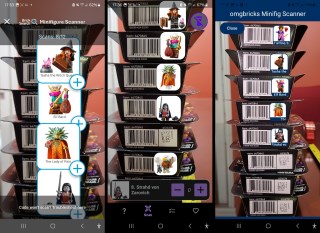
Our recent article about Brick Search Plus prompted criticism that we were promoting it when other potentially superior and free alternatives are available.
Among the most vocal in that conversation was Rasmodius who suggested that we should publish a comparison article to which I replied that we didn't have the time to do so.
Rather than leave it at that, he offered to write it for us. He has comprehensively tested five of the most popular minifig scanning options and concluded which ones work best on each mobile platform:
Minifigure scanning apps have become an important tool for LEGO fans when shopping for Collectable Minifigures (CMFs). When LEGO switched from blind bags to blind boxes in late 2023, it meant that collectors could no longer feel the contents of the packages to find the specific CMF they wanted, or avoid ones they didn’t intend to buy.
Fortunately, beginning with Series 25, LEGO began printing large data matrix codes on the bottom of the CMF boxes and in 2024, we saw the introduction of numerous third-party mobile apps that can read these codes and tell the user which minifigure is inside. This article intends to determine which of these apps perform the best at reading these codes and correctly determining what’s inside.
Summary
If you wish to skip the test results, here is a quick summary of the conclusions:
- If you have an iPhone: omgbricks performed best.
- If you have an Android phone: Minifig Scan and omgbricks performed best.
- If you can’t or won't download an app: Falconbricks Figure Finder may work in your web browser.
Apps Tested
Five of the most popular scanning apps were selected for testing:
- Brick Search
- Falconbricks Figure Finder
- Jay’s Brick Blog Minifig Scanner
- Minifig Scan (Android | Apple)
- omgbricks
However, I was not able to successfully scan a single box using Jay’s Brick Blog Minifig Scanner on either of the Android or iPhone test phones, and therefore could only proceed with testing the other four apps. I was unable to successfully scan any boxes using the Falconbricks Android app but their website scanner did work on the iPhone. All apps were tested with the latest versions available as of November 24, 2024.
Test Setup
All tests were conducted in the same room, under the same lighting conditions, using Dungeons & Dragons Collectable Minifigures boxes from the USA. For the accuracy test, all 12 boxes from the series were used in order to verify that each app could correctly identify the entire series.
For the short, medium, and long range scanning tests, seven of the boxes with the most clearly printed barcodes were chosen to ensure that none of the apps would have their scores affected by a poorly printed barcode. All Android tests were performed using a Samsung Galaxy S21, and all iPhone tests were performed with an iPhone 13. Both devices were stabilised by placing them on a stand for all tests.
The apps were subjected to five different tests: accuracy, number of simultaneous scans, and three different distance tests. The accuracy test determined whether the apps correctly identified the minifigures inside, the simultaneous scans test determined how many boxes the apps could identify at once, and the three distance tests evaluated how flexible the apps were with successfully scanning boxes in a range of positions. An app that is capable of scanning successfully at a range of distances will be easier to use than something that requires very specific positioning.
Accuracy
The first and most important test of all is accuracy. Any other features become irrelevant if the app cannot tell you which minifigure is inside the box. This test was conducted by scanning a full set of 12 boxes of the current Dungeons & Dragons Collectable Minifigures series, one box at a time. The boxes were opened to verify the contents and compared against the scanning results of each app.
We can see that all of the tested apps scanned all 12 Dungeons & Dragons boxes correctly. This is great to see and shows that users can have confidence that all of these apps can deliver correct results.
Short Distance Scanning
This test was conducted by placing the phone on a stand, then positioning a stack of seven boxes 6 inches in front of the phone. I allowed each app as much time as it needed to focus on and scan the boxes, then recorded the maximum number of boxes that were scanned simultaneously from this distance.
All apps performed well at short distance and did not have trouble identifying barcodes. On iPhone, the three apps with multiple box scanning capability each identified four boxes, while Falconbricks identified one.
On Android, Minifig Scan and omgbricks each identified five boxes, while Brick Search identified four.
Medium Distance Scanning
The medium distance scanning test was conducted in the same manner as the short distance test, but this time the stack of seven boxes was placed 9 inches in front of the phone on the stand. Again, the apps were given as much time as they needed to focus on and scan the boxes, and the maximum number of simultaneous scans was recorded.
On iPhone, omgbricks identified four boxes, while both Brick Search and Minifig Scan identified three boxes. Falconbricks was not able to scan a box at this distance, even with the zoom slider at the maximum setting.
In the Android test, Minifig Scan and omgbricks both identified four boxes, while Brick Search did not identify any.
Long Distance Scanning
The phone was again situated on a stand and the stack of seven CMF boxes was now placed 12 inches in front of the phone. Once again, the apps were permitted as much time as they needed to scan the boxes and the maximum number of simultaneous scans was recorded.
On iPhone, omgbricks continued to identify four boxes at long distance. Minifig Scan repeated its result from the medium distance test and scanned three boxes at long distance. Brick Search identified one box at long distance. Falconbricks was again not able to scan any boxes.
On Android none of the apps were able to scan any boxes from 12 inches away. Minifig Scan and omgbricks had a max scanning distance of 10 inches on the Galaxy S21, while I was unable to scan any boxes past the 6 inch distance using Brick Search.
Maximum Simultaneous Scans
For this test, all 12 boxes were stacked in two columns in front of the phone. Scanning was performed at a variety of distances to see how many boxes each app could scan at once. Each app was given as much time and repositioning as was needed to find its optimal scan distance and record its maximum number of simultaneous scans.
All of the iPhone apps appeared to be limited to four simultaneous scans, with the exception of Falconbricks which scanned one at a time. Minifig Scan and omgbricks were both able to scan five boxes simultaneously on Android, while Brick Search scanned up to four at once.
Offine Scanning
I attempted to scan boxes after disabling the internet connection on the test phones. Minifig Scan and omgbricks were able to scan boxes without an internet connection. I was unable to successfully scan using Brick Search or Falconbricks Figure Finder without an internet connection.
About the Apps
Brick Search
Brick Search scanned boxes accurately, and scanned up to four boxes at a time during testing. It had diffculty scanning boxes at longer distances and unlike the other scanner apps, it requires a paid subscription to use after 12 scans. Users can add minifigures to their collection from the scanner and the app has other LEGO features as well. The app claims to support offline scanning, but I was not able to scan successfully without an internet connection.
Falconbricks Figure Finder
Falconbricks Figure Finder is free to use, scans one box at a time, and seemed to require the box to be at a very specific distance in order to scan. It is much slower to scan boxes with this app as compared to the others and I could not get it to scan on Android, but it is an option to try for anyone who cannot download a scanner app.
Minifig Scan
Minifig Scan identified up to four boxes at a time on iPhone, and five at a time on Android. It scanned multiple boxes at all three test distances. This app tied for first place in the Android testing, and was second best in the iPhone tests. It also allows users to mark which minifigures they have already collected and it works offine. Minifig Scan is free, with a popup to tip the developer.
omgbricks
omgbricks scanned up to four boxes at a time on iPhone, and five at a time on Android. It was the best app in the iPhone tests, tied for first place in the Android testing, and worked without an internet connection on both platforms. On iPhone, users can add scanned minifigures to their collection and there are other features for LEGO collectors. omgbricks is free to use.
Which App Should You Use?
In the iPhone tests, omgbricks performed very strongly. It scored at the top of every test, and during testing it seemed to more steadily display scan results even when other apps’ displays were periodically disappearing and reappearing. My observations matched the test results as I found omgbricks seemed most ‘eager’ to scan the boxes placed in front of it.
On Android, Minifig Scan and omgbricks tied for first place in all tests and had the same maximum scan distance of ten inches. Again, my observations mirrored the test results as both Minifig Scan and omgbricks were the easiest to use and scanned boxes faster and more reliably than the other two apps being tested.
Based on these test results, omgbricks would appear to be the overall winner, especially on iPhone. Minifig Scan also performed very well, particularly on Android. The other two apps tested, Brick Search and Falconbricks, did not perform as well as omgbricks or Minifig Scan. Both omgbricks and Minifig Scan are free, and great at scanning boxes quickly, which is helpful if you wish to be less conspicuous while scanning in a store, or to check a large quantity of boxes.
Thank you Rasmodius for an excellent article!
252 likes
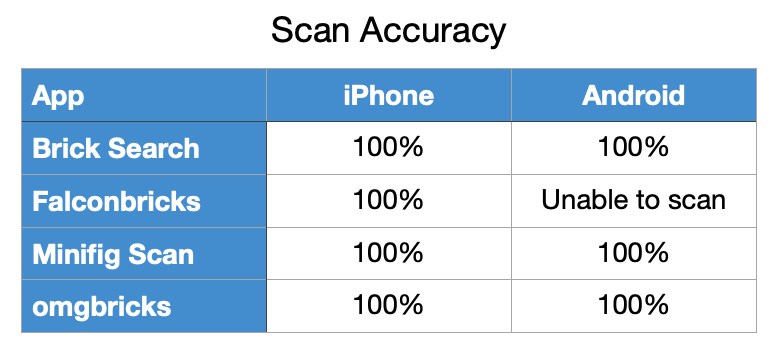
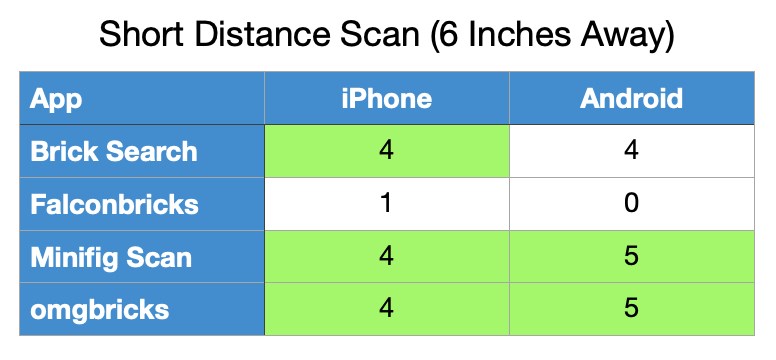
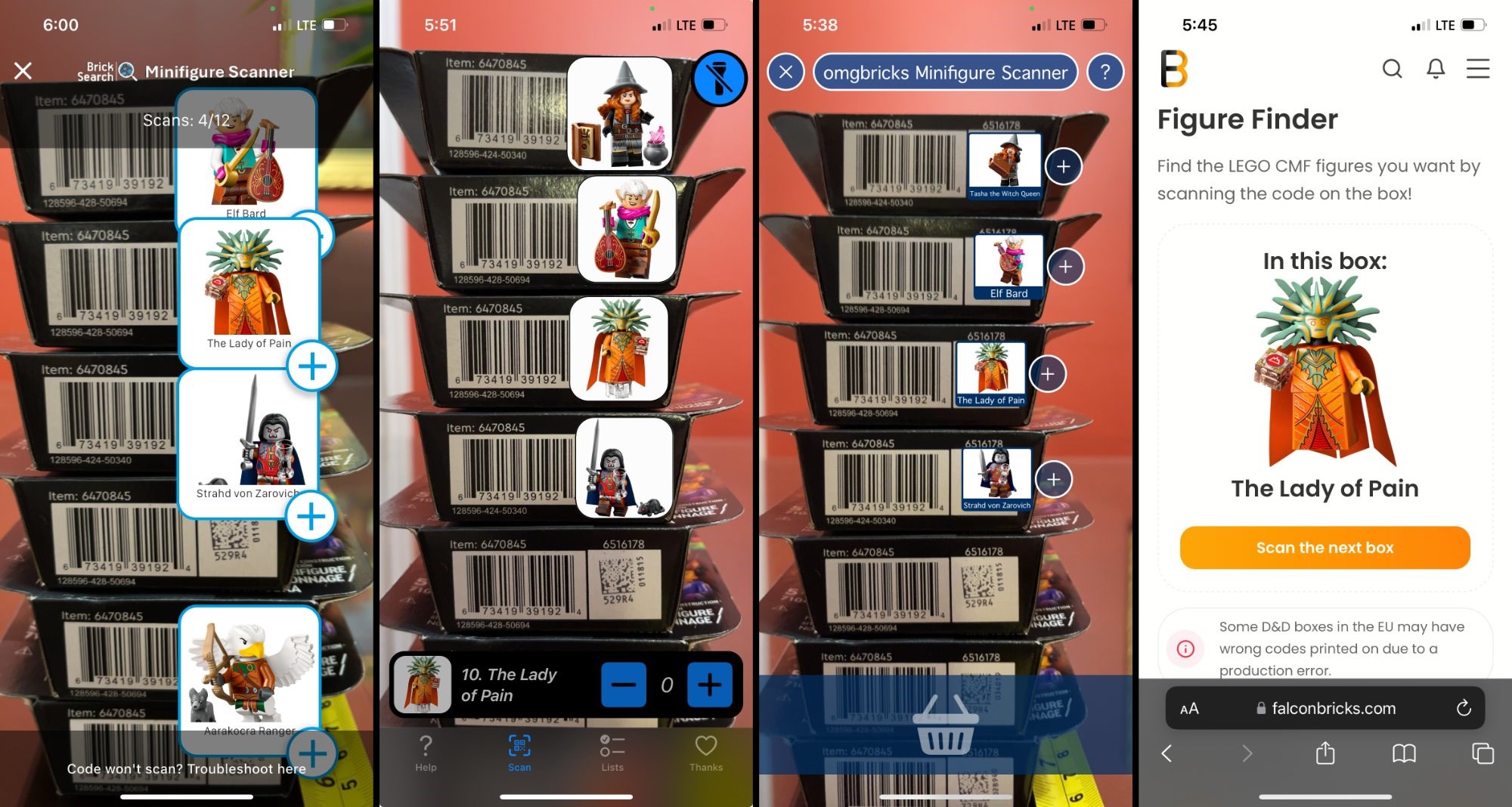

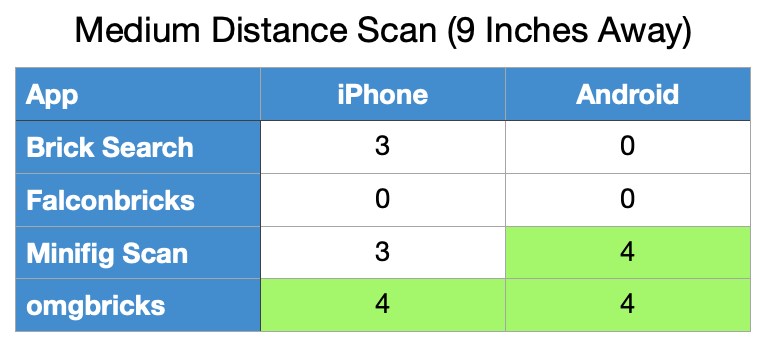
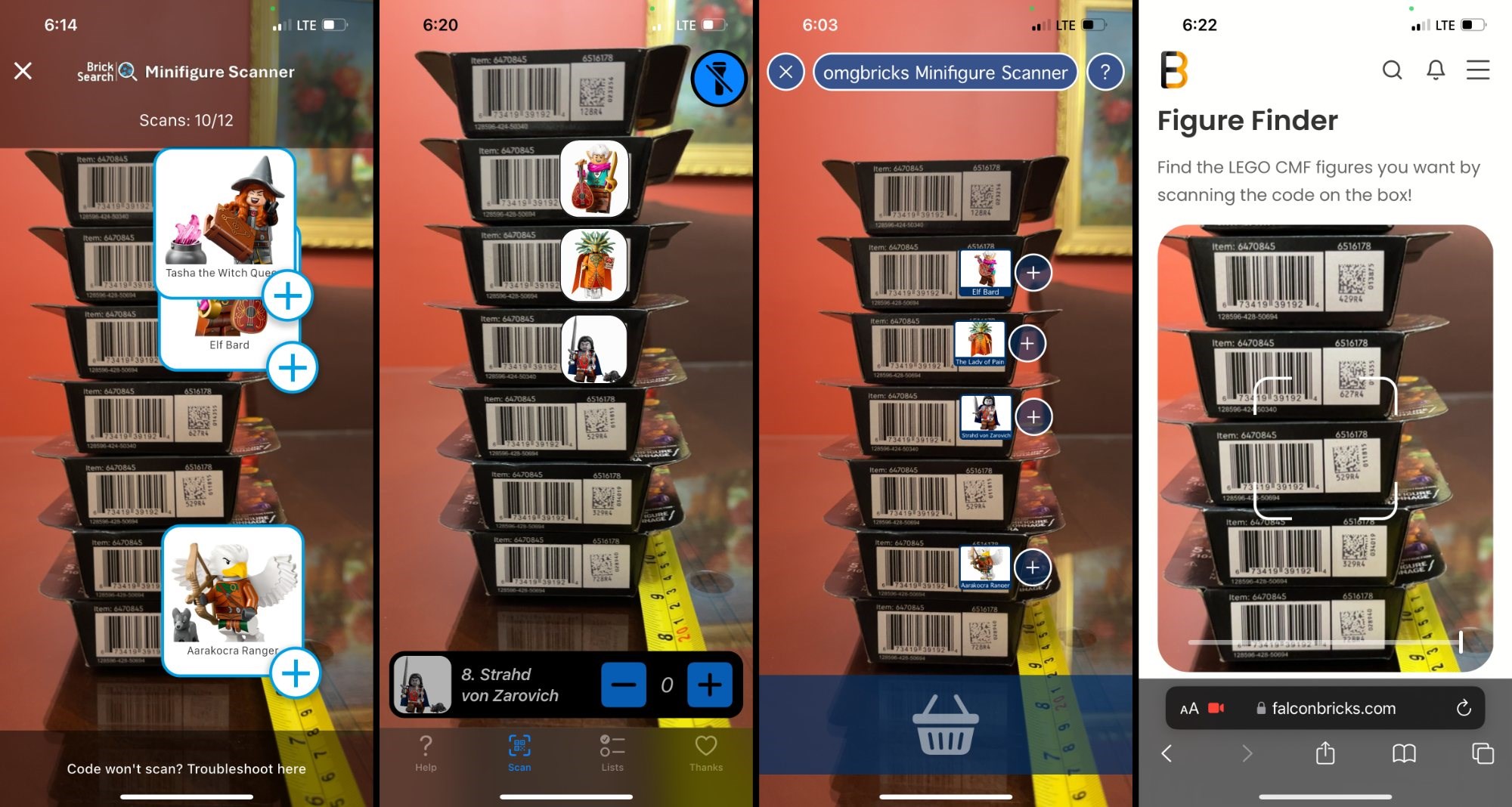
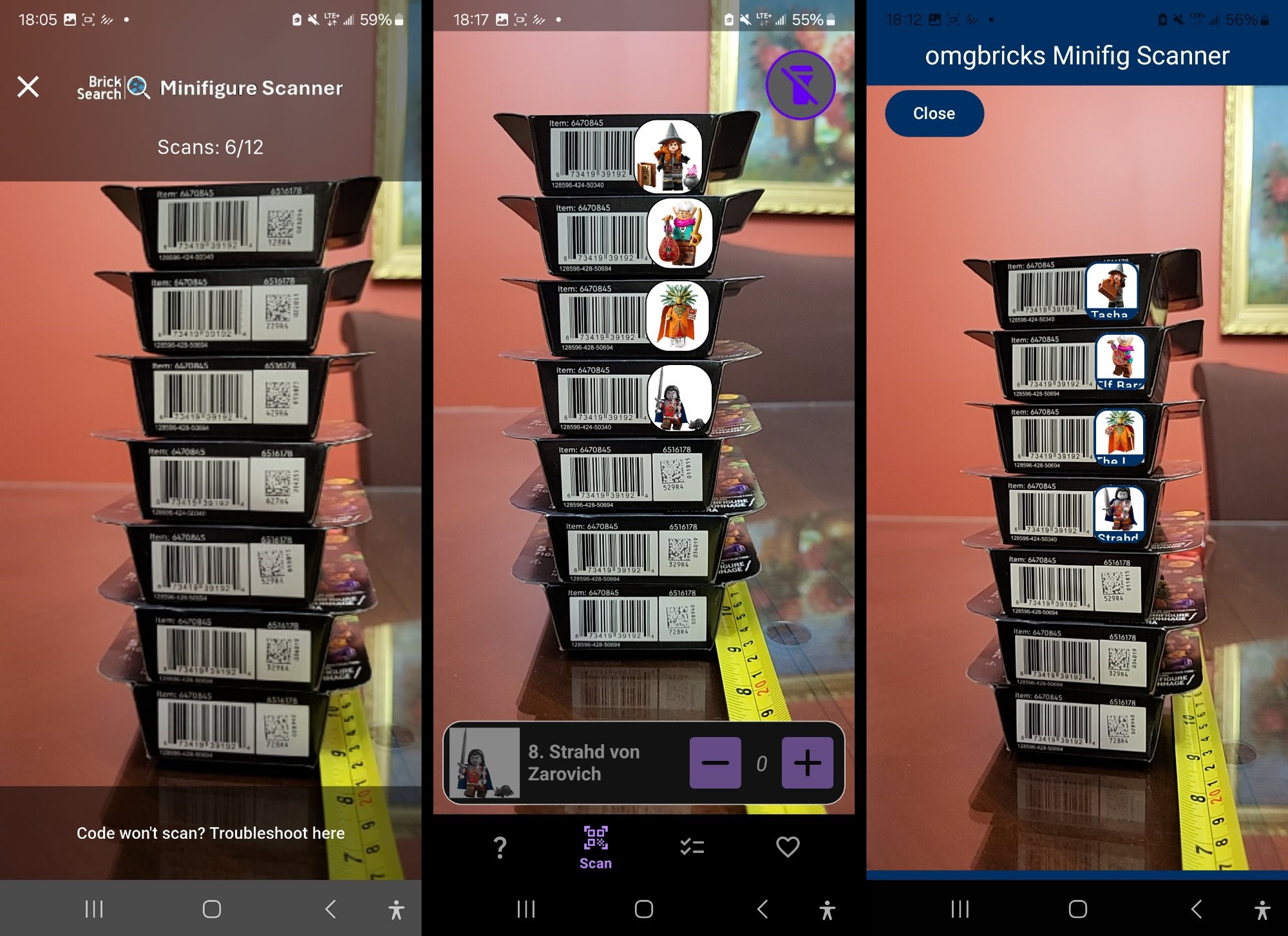
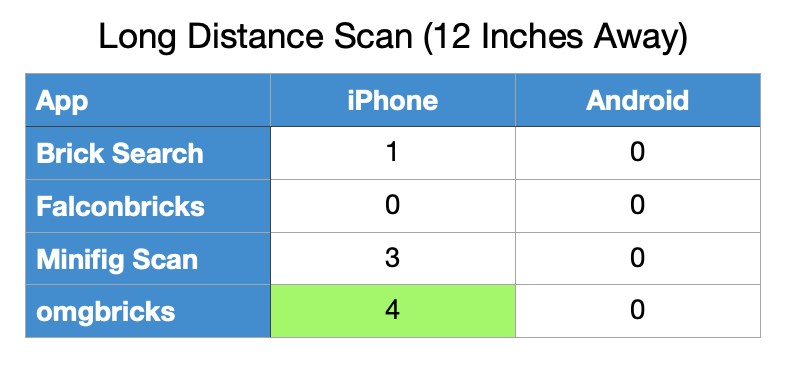
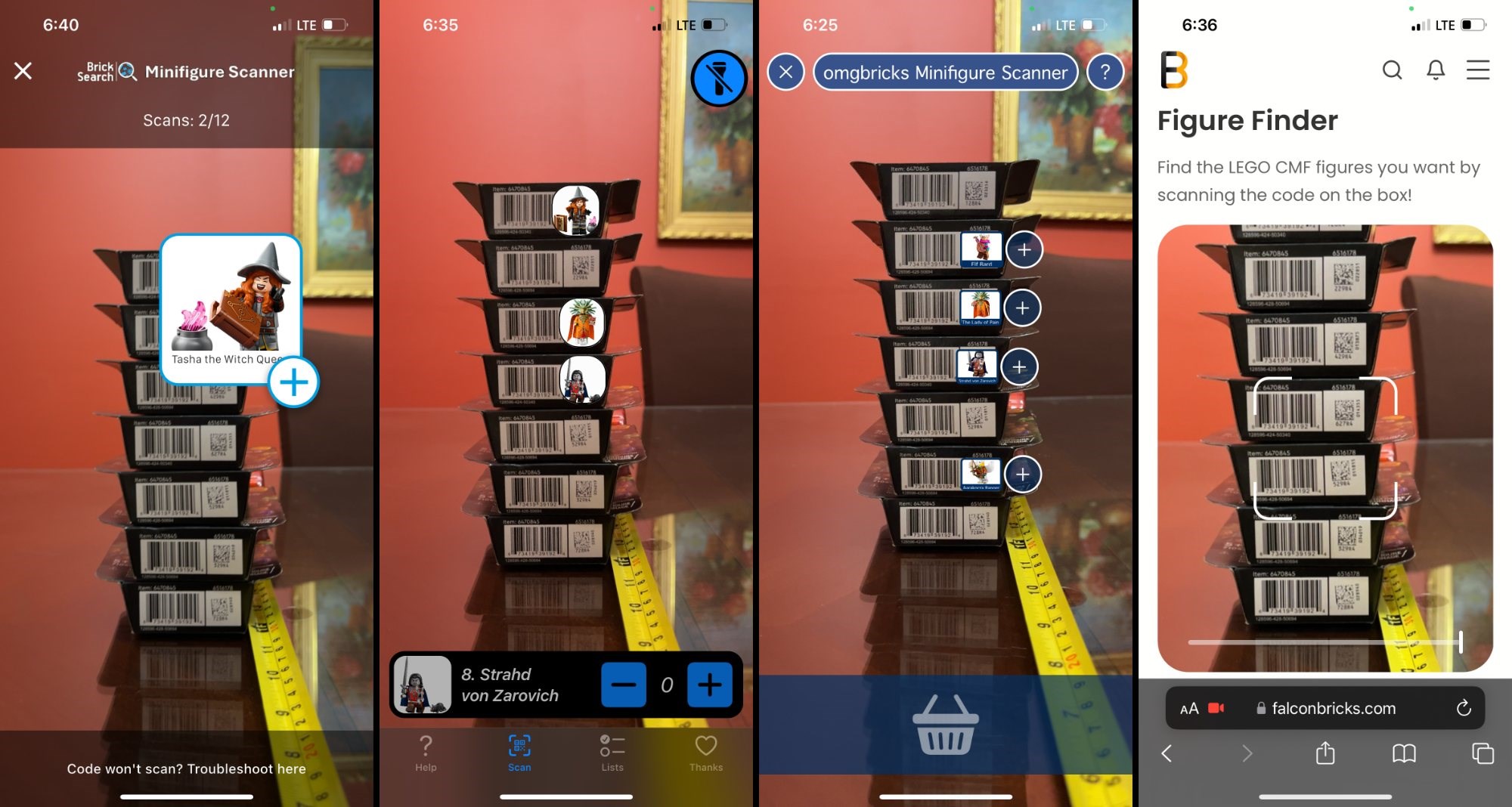
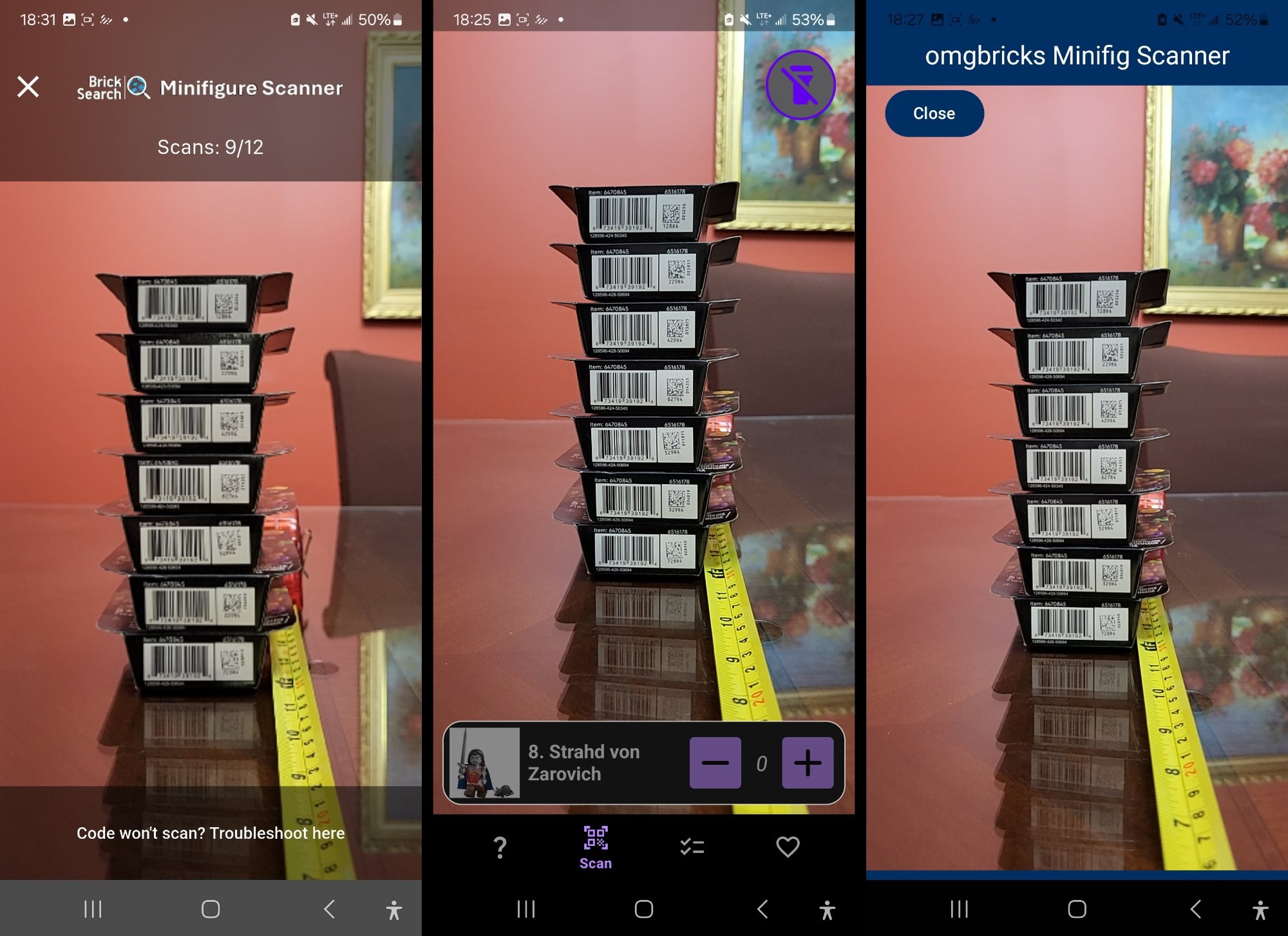
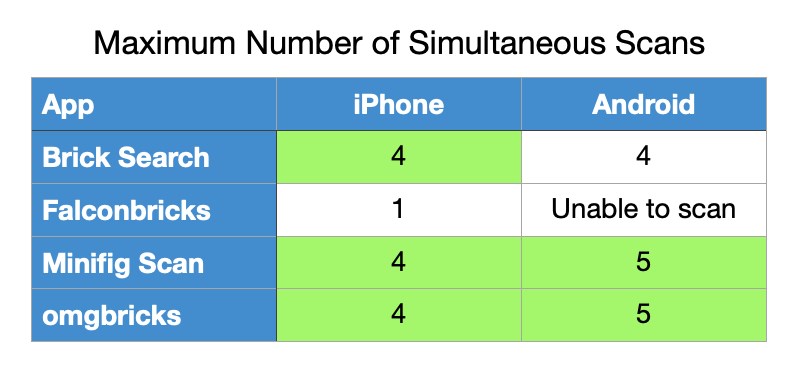
46 comments on this article
Major kudos to @Rasmodius for doing this and testing all these apps out. Major credit deserved and won by him.
As for what this shows, think it proves beyond a shadow of a doubt that when it comes to minifigure scanners, there are far better alternatives out there to Brick Search that not only perform better, but are 100% free too.
I'll definitely be using Minifig Scan on my Android Phone for the next series.
The Jay's Brick Blog scanner works perfectly fine on my pixel phone fwiw. Bricking Around is another lego blog with its own in-browser scanner that also works perfectly fine on my phone. However both are quite slow, they dont show thumbnails over the qr code but rather do a little animation and then show a big picture, its very annoying. I wouldnt want to try to scan for a full set with either, although Ive personally never wanted a full set anyway.
Thanks for the review and the effort put in it!
I changed to omgbricks after reading the comments on the last article about Brick Search. And I am very satisfied with it!
I have been using Falconbricks (on Android) in offline settings and I have to say that I have found it to be much more reliable than Brick Search! It also was not that slow, maybe five seconds loading per scan?
I've never failed with the Jays Brick Blog scanner so I've no idea why it didn't work for you. I used it yesterday and even the codes that looked a bit faded or slightly misprinted were scanning with no issues.
I have a 5 or 6 year old budget phone with a not-great camera so that can't be a factor.
I've used the falconbricks web scanner on my android phone for the past few series and it's been 100% accurate.
Thanks for the info!
Thanks to @Rasmodius for the thorough work done on testing these apps. Happy someone pushed back on the blatant promotion for a subscription-based scanner and actually putting in the work to prove there are free alternatives that work well -- and likely even way better.
Honestly, having used the free version of Brick Search myself, I wouldn't recommend anyone paying for it, nor promoting it without having tested it. I'm sure the subscription-based version is improved, but given the glitchiness and slow performance of the free version, I wouldn't take the risk.
I'll install omgbricks now.
There is also FAN KLOCKÓW one. It works best for me on Adroid and can scan one after another
Am I really weird for just using a QR scanner and having a note with all the names and numbers^^
@watcher21 said:
"Am I really weird for just using a QR scanner and having a note with all the names and numbers^^"
Same, never had to resort to installing an app.
@magmafrost said:
"The Jay's Brick Blog scanner works perfectly fine on my pixel phone fwiw. Bricking Around is another lego blog with its own in-browser scanner that also works perfectly fine on my phone. However both are quite slow, they dont show thumbnails over the qr code but rather do a little animation and then show a big picture, its very annoying. I wouldnt want to try to scan for a full set with either, although Ive personally never wanted a full set anyway."
Came here to say this
I ended up with the Omgbricks app after getting frustrated with the slow pace of scanning individual codes and comparing the numbers against a list, and it made picking up the DnD series a breeze. My experience matches the test, I was genuinely surprised how quickly and easily it scans multiple boxes at once.
Thanks @Huw for posting this article. I really appreciate the work you've put into this site. It is one of the only websites I visit on a daily basis.
Receiving feedback on your creation from so many disparate personalities must be challenging. You've always handled it gracefully. Thanks again for all your years of dedication and effort. This site means a lot to a lot of people- and it is because of you.
@tkatt, thank you for your kind words.
Could not get the Brick Search app to work, whereas Minifig Scan worked very well.
Not surprised that the BrickFanatics app didn't work well, I'm just surprised that every minifigure you scanned didn't come with a "to read more about Harry Potter issues click here:" or "amazing offer as this minifigure has currently got 1% off".
Omg is the only one that has worked for my android phone. I don't know the technical details but all the others the barcode was blurry and would not focus no matter the distance scanned. Omg bricks for the win
I have used Minifig Scan for a while now and it works perfectly on my Android phone.
I used to use the standard QR code scanner in conjunction with a paper list, but to be honest I find using an app like Minifig Scan much more convenient.
@omnius said:
" @watcher21 said:
"Am I really weird for just using a QR scanner and having a note with all the names and numbers^^"
Same, never had to resort to installing an app."
I did the same for the first series where the QR codes became a thing. Have to say while nothing wrong with this method, I find it just so much easier having an app tell you exactly which one it is without resorting to the code lists.
That said, I'll still have a pen an paper list with the figures on so I can mark them off as I find them.
Great article, thank you for doing this! I've been using Brick Search with mixed results. I'll definitely give omgbricks a try.
My takeaway is that if anyone tells Huw in the comments that you are willing to write an article, you’d better warm up those typing fingers.
A big thanks to @Rasmodius for the effort in testing and for compiling this very informative and useful article.
And of course a big thanks to Huw for making it possible to be published on his site.
A few weeks ago I commented that I had noticed that Brick Search had limited scans to 12 and thereafter continued use required a paid for subscription. I deleted Brick Search and replaced it with Minifig Scan.
Thanks again to @Rasmodius and to Huw :)
As an iphone user I will now also download omgbricks
Awesome thanks.
For those that use the web scanners it always wants to use my selfie front camera which is much harder to is is there a way to make it switch cameras?
Slightly embarrassing for Brick Search to have done so poorly.
The only thing that matters to me is the accuracy.
@johleth said:
"Slightly embarrassing for Brick Search to have done so poorly."
It is a shame what has happened to BrickFanatics (as this is their app) it used to be a really good site run by one dedicated fan in his free time, a media group took it over and has turned it into a click-bait advertisement heavy website.
Their app, which I never found to work well anyway, will soon be in trouble with a subscription based model.
@MegaBlocks said:
" @johleth said:
"Slightly embarrassing for Brick Search to have done so poorly."
It is a shame what has happened to BrickFanatics (as this is their app) it used to be a really good site run by one dedicated fan in his free time, a media group took it over and has turned it into a click-bait advertisement heavy website.
Their app, which I never found to work well anyway, will soon be in trouble with a subscription based model."
It certainly isn't a good advertisement that their paid app comes in last place against free ones.
Respect for the test.
Minifg Scan was recommended to me by LEGO employees in Billund store, runs flawlessly for me.
@legobuilderstudios said:
"I have been using Falconbricks (on Android) in offline settings and I have to say that I have found it to be much more reliable than Brick Search! It also was not that slow, maybe five seconds loading per scan?"
Since you use Android, you might want to test out Minifig Scan. I'm on Android, and it only takes me 1-2 seconds per scan!
I use the Minifig Scan app on my 7 year old iPhone 8 with absolutely no issues. I only switched to it when I heard the OMG one (which also worked flawlessly) was having issues with a rare case issue in the latest D&D ones.
First time I found out about omgbricks I posted on Reddit and got 180 likes.
https://www.reddit.com/r/lego/comments/1fs6pmu/comment/lpig3e5/
I myself have been able to scan up to 9 boxes at a time using omgbricks using my iPhone 14, so it differs a little bit form @Rasmodius "Maximum Simultaneous Scans" breakdown.
This helped me complete the D&D set today! No more interpreting QR codes
I used to use some web-based scanner, which of course didn't even load if you didn't have internet. And you'd have to hold each box against a neutral background, get the camera the right distance away (because zoom wasn't built into the program in any capacity), and cross your fingers. Sometimes I'd run into boxes that just wouldn't scan. Now I'm using Minifig Scan, and I can pick them up three at a time and just wave it over them against any background, and it'll get all of them. Maybe not all simultaneously, but you just wave it over them a few times until you've been able to look at each tile.
I guess part of the reason some of these apps are having a tough time scanning even one, while others can scan multiple codes at the same time, is because the early solutions weren't restricted in what type of codes they could scan. So they're looking for UPC, QR, and any other code format your device has the ability to recognize. Minifig Scan, and probably the OMG app, only scans the 2D codes on the minifig boxes and nothing else. So it's not wasting effort on looking for _everything_ that might be a code.
@B_Space_Man said:
"My takeaway is that if anyone tells Huw in the comments that you are willing to write an article, you’d better warm up those typing fingers. "
This gave me a good chuckle, well done.
Thanks Huw for publishing this and thank you to everyone who read it. I certainly have a renewed appreciation for the work of all Brickset contributors because writing even a single article takes more time than you might think. I'm glad to have been able to contribute to this great site.
If you make 2 stacks of the boxes but make one of the stacks be upside down then you can have both stacks of QR codes almost next to each other. That allows you to scan more at once and/or have the codes bigger which probably improves the success rate when scanning multiples. We found that Minifig Scan doesn't care about the orientation of the codes. We only did 4 at a time but next time we will try 6 and 8.
Thanks for this. I've tried the Jay's Brick Blog scanner many times on my iPhone SE2 to no avail. I don't know if it's because it's a single-sensor camera or what, but it just never worked for me.
I just installed omgbricks and it did a phenomenal job, even in poor light.
Unfortunately I also found out that of the 18 D&D minis I grabbed, four of them are Strahd.
@chief7575 said:
"I've used the falconbricks web scanner on my android phone for the past few series and it's been 100% accurate. "
Well, it's already bad. Being inaccurate would be really bad.
I prefer jay's brick blog's :)
@GrizBe said:
"I did the same for the first series where the QR codes became a thing. Have to say while nothing wrong with this method, I find it just so much easier having an app tell you exactly which one it is without resorting to the code lists. "
I remember when CMF baggies switched to the indented dots there were more than just one set of american and one set of european codes, so I would say to be truly safe I would always use an app and not a list of codes just in case one comes across a new set of codes one was simply unaware of.
MORE kudos to @Rasmodius for doing this and testing all these apps out. Just brilliant.
And many thanks to Huw for posting this.
I have been using Falconbricks with limited success so will deffo be switching to omgbricks
You have no idea how happy seeing this article makes me. Huge thanks to @Rasmodius and thank you @Huw for being so fair.
Also congrats omgbricks on first place!
@Tuzi said:
"You have no idea how happy seeing this article makes me. Huge thanks to @Rasmodius and thank you @Huw for being so fair.
Also congrats omgbricks on first place!"
Same here, great article, very good to have it here at BrickSet !!
Excellent article, thanks for putting the effort into doing the tests.
@pirro:
2D barcodes like this and QR codes have the orientation coded into the matrix. Linear barcodes like UPCs can work with a 2D scanner, but also have the orientation coded into them (UPC gets really weird because the numbers in the second half are photo negative versions of the numbers in the first half). Only when you try to scan a linear barcode with a linear scanner will orientation be a problem. If the scanner light is perpendicular to the barcode, it won't even notice that a barcode is in front of it. Grocery stores when I was growing up solved this problem by installing two linear scanners perpendicular to each other. If one didn't get it, the other did.
we have bad batches in EU, only minifig scan will tell you that you are most likely to get something else. I know one guy who bought 2 dragonborns and it was mindflyer because he used wrong app...
Thanks to @Rasmodius for such a great comparison, I didn't even know that there were so many CMF scanning apps and pages out there!
I always used the finger feeling method with the plastic bags, it took me a long time to find the ones wanted but I only failed two times in over 200 minifigures, it was kind of a hobby by itself. With the change to blind boxes this came to an end. I have used a simple QR reader app to see the numeric code and check that in a webpage or image with the codes of the complete series, and it has worked for me but it's also very time-consuming (you can only read one code, then change to the webpage or image to check what minifigure is it, and then change again to the reader app to scan another code).
I've just installed omgbricks app and have tested it with my entire D&D collection, I have managed to scan up to 8 minifigures at the same time. I suppose it depends on phone camera resolution, good lighting and a firm hand while scanning. So it'll save me a lot of time with the next CMF series for sure!